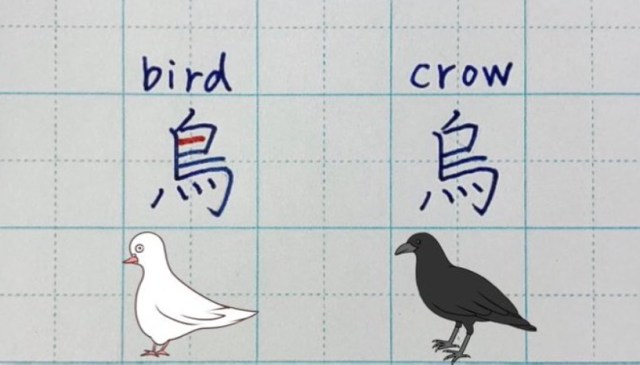
Learn how to never mistake the two kanji ever again.
With thousands of kanji to learn in the Japanese language, it can be hard to remember them all, especially when there’s only one stroke difference between some of them. However, knowing the etymology of the kanji can help a lot when it comes to creating a permanent, unshakeable foundation by which to recall them, and one instance is the history behind the kanji for the word “crow”.
▼ “Crow“, or “karasu” as it’s known in Japanese, looks strikingly similar to the kanji for “bird“, or “tori“.
The above image, shared online by Japanese teacher Kayo sensei, who goes by the handle @kayoshodo on Twitter, asks why the kanji for “crow” is missing that one line in the centre marked in red. Kayo sensei is here to explain the reason behind it all with a look at the original image from which the kanji for “bird” came from.
The horizontal stroke represents the eye of the bird, which is easily visible when the bird is white or relatively pale in colour. However, the crow is jet black, making the eye hard to make out, and this is the reason why there is no horizontal line in the kanji for “crow”.
Knowing the reason behind this small difference in appearance makes it easy to distinguish between the two similar kanji, and it’s something a lot of Japanese learners online were grateful to learn, sending Kayo sensei’s tweet viral with over 31,000 likes and 8,000 retweets.
A kanji of crow is one less horizontal stroke compared with a character of bird.
— Kayo sensei (@kayoshodo) July 22, 2020
Why??
This horizontal stroke express their eyes, but we can't find where crow's eyes are because they are all black.
So, the kanji of crow has no eyes(one horizontal stroke) in it.🤗 pic.twitter.com/ydRxyJFQja
▼ Her quick crow kanji tutorial was also a hit on Instagram:
https://www.instagram.com/p/CC9ai7WnkM8/?igshid=h9r0nkk57qo
The kanji for “bird” actually acts as a base kanji for a number of avian species to build upon. For instance, the kanji for “pigeon” or “hato” in Japanese adds the kanji for “nine” (pronounced “ku”) to the left of “bird”, as this reflects the “kuu kuu” sound pigeons make.
This character means pigeon( はとhato).
— Kayo sensei (@kayoshodo) July 22, 2020
This character is based on the sound of pigeon. 🕊
The pronunciation of the left part of character is "ku ". Pigeon cries like "kuu, kuu", so old people applied this kanji to pigeon.
(The right part means bird.) pic.twitter.com/l1Ie45T9On
It’s a fascinating look at some of the ways kanji have developed over the years, and the real-world scenarios embedded in their etymology really help to cement them in our brains. For more tips on learning and remembering kanji and ways to quickly improve your writing skills, be sure to give Kayo sensei a follow on Twitter and Instagram.
And if you really want to up your kanji game, you might want to review the kanji with the longest readings and master the top five most difficult kanji ever. Happy studying!
Source: Twitter/@kayoshodo, Instagram/kayo_japanese_lesson
Top image: Instagram/kayo_japanese_lesson
Insert images: Instagram/kayo_japanese_lesson
● Want to hear about SoraNews24’s latest articles as soon as they’re published? Follow us on Facebook and Twitter!

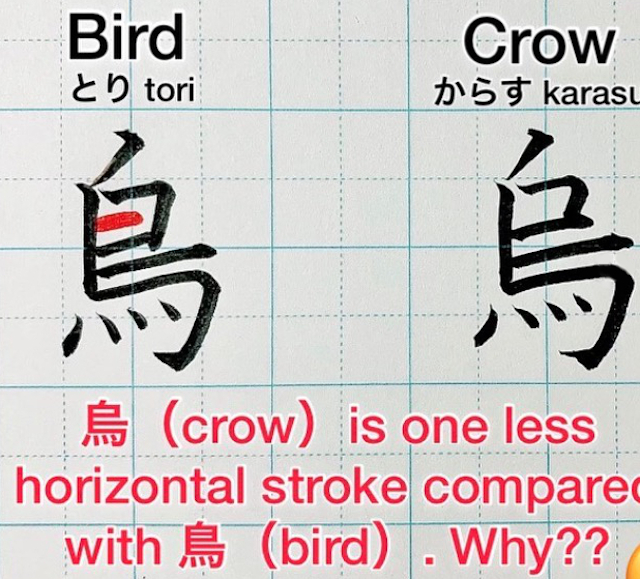
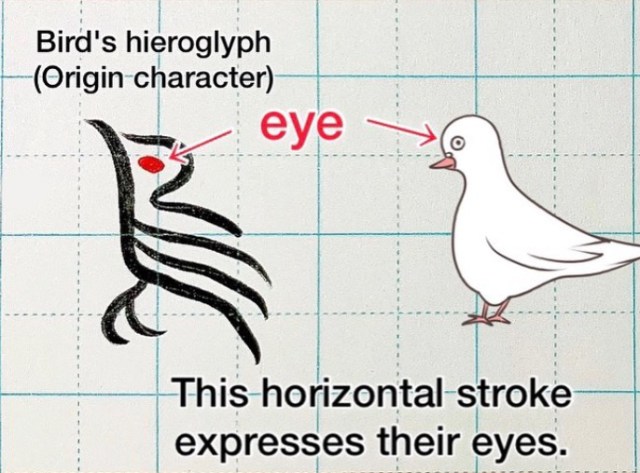
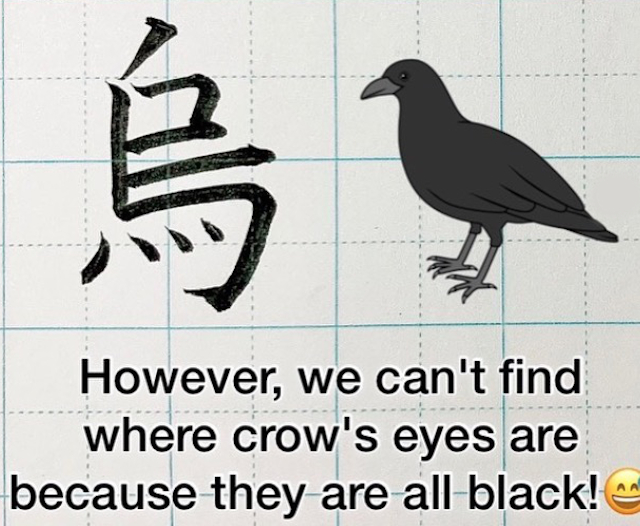
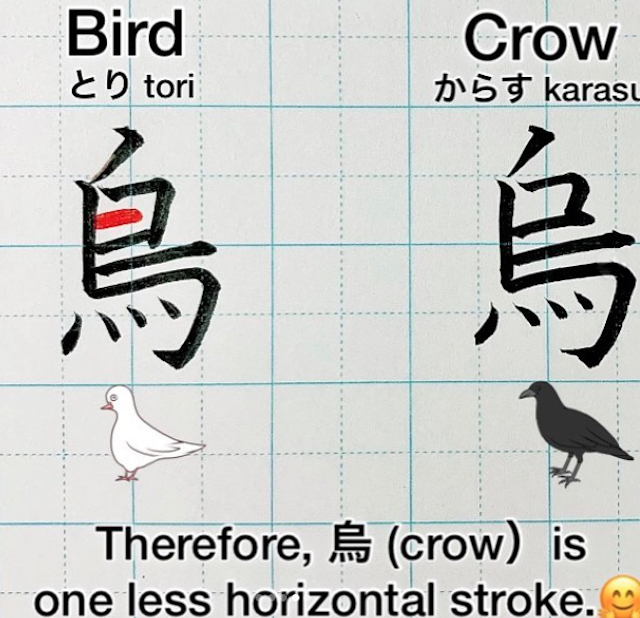
 Top Japanese cosplayer Enako returns to Comiket after 6 years, creates mayhem with admirers
Top Japanese cosplayer Enako returns to Comiket after 6 years, creates mayhem with admirers The Purple Lucky Bag from Village Vanguard is an extra-large waste of money
The Purple Lucky Bag from Village Vanguard is an extra-large waste of money Rakuten randomly offers 58 New Year’s osechi feasts in Japan, but did we get a star or a dud?
Rakuten randomly offers 58 New Year’s osechi feasts in Japan, but did we get a star or a dud? 9 middle-aged Japanese men try putting on their own makeup
9 middle-aged Japanese men try putting on their own makeup Nearly one in ten young adults living in Japan isn’t ethnically Japanese, statistics show
Nearly one in ten young adults living in Japan isn’t ethnically Japanese, statistics show Top Japanese cosplayer Enako returns to Comiket after 6 years, creates mayhem with admirers
Top Japanese cosplayer Enako returns to Comiket after 6 years, creates mayhem with admirers The Purple Lucky Bag from Village Vanguard is an extra-large waste of money
The Purple Lucky Bag from Village Vanguard is an extra-large waste of money Rakuten randomly offers 58 New Year’s osechi feasts in Japan, but did we get a star or a dud?
Rakuten randomly offers 58 New Year’s osechi feasts in Japan, but did we get a star or a dud? 9 middle-aged Japanese men try putting on their own makeup
9 middle-aged Japanese men try putting on their own makeup Nearly one in ten young adults living in Japan isn’t ethnically Japanese, statistics show
Nearly one in ten young adults living in Japan isn’t ethnically Japanese, statistics show That time Seiji called JASRAC to ask why he didn’t get paid royalties for his song being on TV
That time Seiji called JASRAC to ask why he didn’t get paid royalties for his song being on TV Japan’s super easy sweet potato spread lets you make sweet potato bread thanks to Don Quijote
Japan’s super easy sweet potato spread lets you make sweet potato bread thanks to Don Quijote Record number of foreign children in Japan need help understanding Japanese in school
Record number of foreign children in Japan need help understanding Japanese in school We visit the 24-hour male-only sauna just outside of Hakata Station and ponder a strange sight
We visit the 24-hour male-only sauna just outside of Hakata Station and ponder a strange sight Dragon Quest Burgers and Slime drinks are coming to McDonald’s Japan【Video】
Dragon Quest Burgers and Slime drinks are coming to McDonald’s Japan【Video】 Starbucks Japan ready to get Year of the Horse started with adorable drinkware and plushies【Pics】
Starbucks Japan ready to get Year of the Horse started with adorable drinkware and plushies【Pics】 Japanese beef bowl chain Sukiya’s 2026 Smile Box lucky bag basically pays for itself
Japanese beef bowl chain Sukiya’s 2026 Smile Box lucky bag basically pays for itself Hayao Miyazaki says Happy New Year to Studio Ghibli fans with new art for Year of the Horse
Hayao Miyazaki says Happy New Year to Studio Ghibli fans with new art for Year of the Horse Cup Noodle tries an authentic Jiro-style ramen, but something’s not quite right
Cup Noodle tries an authentic Jiro-style ramen, but something’s not quite right The best Starbucks Japan Frappuccinos we want to drink again in 2026
The best Starbucks Japan Frappuccinos we want to drink again in 2026 We revisited Sweets Paradise after a decade to see if Japan’s dessert buffet still delivers
We revisited Sweets Paradise after a decade to see if Japan’s dessert buffet still delivers We found possibly the quietest Japanese-style hotel in Tokyo’s bustling Shinjuku district
We found possibly the quietest Japanese-style hotel in Tokyo’s bustling Shinjuku district Pizza Hut Japan’s hot lucky bags are perfect for a New Year’s pizza party
Pizza Hut Japan’s hot lucky bags are perfect for a New Year’s pizza party Japan’s oldest largetooth sawfish in captivity back on display in Mie Prefecture
Japan’s oldest largetooth sawfish in captivity back on display in Mie Prefecture 7-Eleven Japan starts new temporary luggage storage service in over 300 branches
7-Eleven Japan starts new temporary luggage storage service in over 300 branches Disillusionment at Tsukiji’s tourist-target prices led us to a great ramen restaurant in Tokyo
Disillusionment at Tsukiji’s tourist-target prices led us to a great ramen restaurant in Tokyo Starbucks teams up with 166-year-old Kyoto doll maker for Year of the Horse decorations【Photos】
Starbucks teams up with 166-year-old Kyoto doll maker for Year of the Horse decorations【Photos】 Tokyo considering law requiring more trash cans following litter increase in heavily touristed area
Tokyo considering law requiring more trash cans following litter increase in heavily touristed area Tokyo’s Tsukiji sushi neighborhood asks tour groups to stay away for the rest of the month
Tokyo’s Tsukiji sushi neighborhood asks tour groups to stay away for the rest of the month Tokyo event lets you travel back in time, for free, to celebrate 100 years since Showa era start
Tokyo event lets you travel back in time, for free, to celebrate 100 years since Showa era start Japan may add Japanese language proficiency, lifestyle classes to permanent foreign resident requirements
Japan may add Japanese language proficiency, lifestyle classes to permanent foreign resident requirements Sanrio theme park in Japan announces plans to expand into a Sanrio resort
Sanrio theme park in Japan announces plans to expand into a Sanrio resort Stamina-destroying “Paralysis Noodles” are Tokyo’s newest over-the-top ramen innovation
Stamina-destroying “Paralysis Noodles” are Tokyo’s newest over-the-top ramen innovation Survey asks foreign tourists what bothered them in Japan, more than half gave same answer
Survey asks foreign tourists what bothered them in Japan, more than half gave same answer Japan’s human washing machines will go on sale to general public, demos to be held in Tokyo
Japan’s human washing machines will go on sale to general public, demos to be held in Tokyo Japan’s deadliest food claims more victims, but why do people keep eating it for New Year’s?
Japan’s deadliest food claims more victims, but why do people keep eating it for New Year’s? We deeply regret going into this tunnel on our walk in the mountains of Japan
We deeply regret going into this tunnel on our walk in the mountains of Japan Studio Ghibli releases Kodama forest spirits from Princess Mononoke to light up your home
Studio Ghibli releases Kodama forest spirits from Princess Mononoke to light up your home Major Japanese hotel chain says reservations via overseas booking sites may not be valid
Major Japanese hotel chain says reservations via overseas booking sites may not be valid Put sesame oil in your coffee? Japanese maker says it’s the best way to start your day【Taste test】
Put sesame oil in your coffee? Japanese maker says it’s the best way to start your day【Taste test】 No more using real katana for tourism activities, Japan’s National Police Agency says
No more using real katana for tourism activities, Japan’s National Police Agency says Starbucks Japan reveals new sakura drinkware collection, inspired by evening cherry blossoms
Starbucks Japan reveals new sakura drinkware collection, inspired by evening cherry blossoms Updated cherry blossom forecast shows extra-long sakura season for Japan this year
Updated cherry blossom forecast shows extra-long sakura season for Japan this year That time Seiji called JASRAC to ask why he didn’t get paid royalties for his song being on TV
That time Seiji called JASRAC to ask why he didn’t get paid royalties for his song being on TV Japan’s super easy sweet potato spread lets you make sweet potato bread thanks to Don Quijote
Japan’s super easy sweet potato spread lets you make sweet potato bread thanks to Don Quijote Record number of foreign children in Japan need help understanding Japanese in school
Record number of foreign children in Japan need help understanding Japanese in school We visit the 24-hour male-only sauna just outside of Hakata Station and ponder a strange sight
We visit the 24-hour male-only sauna just outside of Hakata Station and ponder a strange sight Dragon Quest Burgers and Slime drinks are coming to McDonald’s Japan【Video】
Dragon Quest Burgers and Slime drinks are coming to McDonald’s Japan【Video】 Where’s the happiest place for foreigners to live in Japan? Study investigates
Where’s the happiest place for foreigners to live in Japan? Study investigates Private booths are coming to Japan’s Shinkansen bullet trains even sooner than we’d thought【Video】
Private booths are coming to Japan’s Shinkansen bullet trains even sooner than we’d thought【Video】 Japanese beef bowl chain Sukiya’s 2026 Smile Box lucky bag basically pays for itself
Japanese beef bowl chain Sukiya’s 2026 Smile Box lucky bag basically pays for itself What makes a good boss in Japan? Workers sound off in survey
What makes a good boss in Japan? Workers sound off in survey Strange English signs in China and Japan really hate vegetables, sometimes threaten to kill you
Strange English signs in China and Japan really hate vegetables, sometimes threaten to kill you Happy New Year from SoraNews24!
Happy New Year from SoraNews24! Japan’s new canned chu-hai with fresh lemon slice: disappointing gimmick or drink revelation?
Japan’s new canned chu-hai with fresh lemon slice: disappointing gimmick or drink revelation? Akira’s Katsuhiro Otomo to design giant mural featuring cyborg fish for Tohoku’s Sendai Airport
Akira’s Katsuhiro Otomo to design giant mural featuring cyborg fish for Tohoku’s Sendai Airport
Leave a Reply